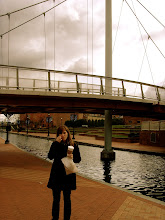I met a busker once on the steps leading up to the Castle. Framed by a graffitied door, the long-haired, gray-bearded musician sat cross-legged with a guitar and a harmonica around his neck. My first reaction was to situate myself against the wall directly opposite him- an angle at which the sun shined direct light on his worn appearance. As I sat against the stone, the man glanced in my direction and smiled. No sooner, however, did he tilt his head downward to watch his fingers move eloquently across the six strings on his instrument. At first, his music seemed melancholy, but before I knew it I had fallen into a gentle stupor, as intrinsic melodies bounced off the enclosing walls and into the calm air above us. It was not sadness, but instead a man sharing his soul with the world- the story of a passion that led him on a much-anticipated and much-needed adventure. Everything about the moment became peaceful and reassuring; and as he let out a final, slow-moving harmonic note, I realized I had just been part of a most-intimate concert.
As he prepared for his next composition, I rose from my front-row seat to place a 10 czk piece in the hat by his side. Beginning to head down the steps, I became inclined to speak to the man and instead turned back around to face him.
“Thank you. That was beautiful playing.”
“Thank you.”
“I’m Kelly. It’s nice to meet you. I play some guitar myself…”
“It is nice to meet you Kelly. I am Ee-oo-lay. You must sit here and play then.”
Much taken aback by his invitation, I naturally hesitated. But as he stood, Ee-oo-lay handed me his guitar and innocently urged me to replace him on the step. Reminding myself that these were the kind of experiences I had been hoping for, I complied with his request and took the guitar from his hands. To my touch it felt smooth and well-kept as if it were the most treasured possession the man owned. Once situated, I looked up at the musician approvingly, and he once again produced a smile.
I began to strum the few chords I knew, and Ee-oo-lay soon blew in on his harmonica. For a brief moment, our stories became one, as we provided for each other what the other needed… in the form of melody and harmony. Studying his face as he played, I could see it warming with each note and lifting him to the place where he had always wanted to be.
Though never to be played again, our tune was forever scripted into my memory of a surprisingly captivating busker in Prague.
When the playing ceased, I thanked Ee-oo-lay one last time.
“I enjoyed playing with you.”
“Yes, me too. My English not so good,” Ee-oo-lay smiled.
“I think you have great English. Goodbye, it was nice meeting you.”
“Yes, thank you. Good bye.”
As I took my final look at Ee-oo-lay I realized that the weathering of years past was no match against his music- against the soul released by the music, and against the person who shared the music with the people around him. The music, and more importantly the busker, had overcome and would never go back.
Excerpt from "For Now, an Untitled Story"



